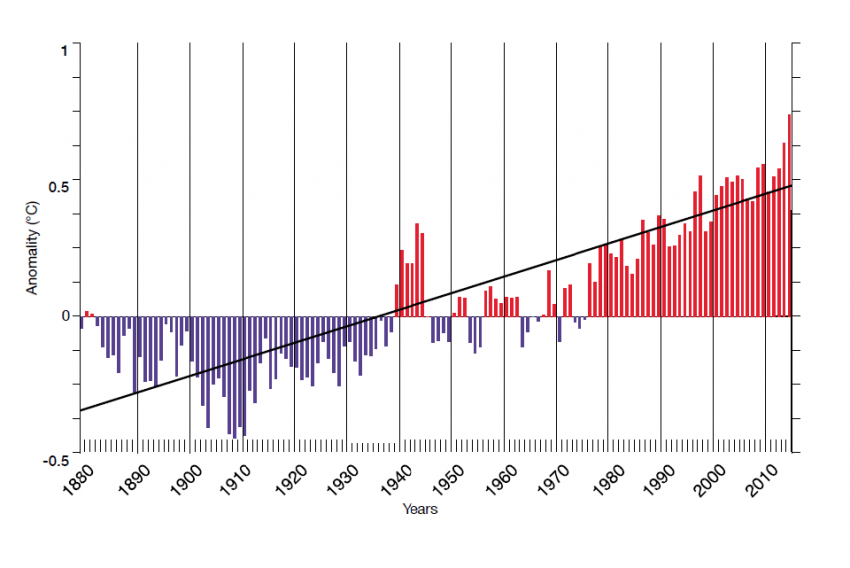One way to measure how humans are rocking the climate is to look at Earth Energy Imbalance in Newton’s language. The idea here is to look at how the quantities of energy received and re-emitted by the climate system of planet Earth can be disturbed and go from equilibrium to imbalance.
On very long-time scales and in the absence of disturbance, the Earth’s climate strikes a balance between incoming energy (that of the Sun) and outgoing energy (that which is sent back into space). This is called the equilibrium temperature.
If an object receives more energy than it loses, its temperature increases. And as its temperature increases, the object will lose more energy.
Equilibrium is achieved when the energy lost by the object is exactly compensated by the energy it receives.
Until then, only two forces were able to modify this balance. The first is naturally the Sun, whose activity can increase and decrease, varying the amount of energy that our small planet receives. The second is volcanism. Major eruptions, like that of Mount Pinatubo (Philippines) in 1991, eject tens of millions of tons of particles at very high altitude which, with the winds, cover the entire globe in a few weeks and reflect sunlight. On average, the five largest eruptions of the 20th century cooled the Earth’s climate by 0.25 ° C.
There is now a third force capable of influencing the climate of planet Earth, humans. “The human influence is now strong enough to disrupt the earth’s energy balance in an obvious way.
Indeed, the advent of the steam engine and de facto human industry since the late 18th century came shoving this balance, with a formidable ingredient, greenhouse gases. This compound capable of absorbing infrared rays and retain heat in the earth system and which human activities will reject more and more with the years and global economic development.
So how does human disrupt the energy balance of the Earth?
Of course, all the extra energy trapped by the planet’s climate system has to be stored somewhere. But where? Here are the current estimates?
In other words, almost all of the solar energy trapped on Earth for 250 years by greenhouse gases emitted by humans has been absorbed by the oceans, which cover 70.3% of the Earth’s surface. A small part only was by land, atmosphere and ice (7%). Yet it is this small share that is responsible for almost all of the global warming measured so far (+1 ° C in 2017 compared to the average temperatures of the pre-industrial era).

The tremendous mass of water in the oceans making them extremely slow to heat. And it slows down global warming, due to their significant inertia. If the Earth had more landmass, global warming would have been much faster and therefore even more destructive for ecosystems. Thus, even if we abruptly reduce our greenhouse gas emissions, so as to regain a similar CO 2 concentration at the pre-industrial level, the ocean waters would continue to slowly release the stored heat.
The threat is all the more real as the rate at which the oceans are absorbing excess human-induced energy is growing dramatically and has never been higher. These absorbed as much energy between 1997 and 2015 as since 1860, according to a study conducted by Peter Glecker & Alii which was published in Nature in January 2016.
This analytical work, based on several hundred climate models, suggests for the first time that the deepest layers of the ocean, those located at a depth of more than 2,000 meters, beyond the measurement capacities of the beacons Argo that roam the oceans, also heat up at high speed. “This work shows that the ‘signals’ of climate change intensify over time and that more of these ‘signals’ are found in the depths of the ocean,” said Dr Matt Palmer, an oceanographer at the Hadley Center of the British Met Office. “The study confirms that the warming of the oceans has continued at the expected rate, the” hiatus “is only a surface phenomenon. The Earth is still warming up, and the oceans have absorbed most of this heat. “
Because of the oceans’ ability to store this excess energy, which acts as a buffer, average surface temperatures “are not a good indicator of global warming on these time scales, ” concludes Schuckmann. The question of how it is absorbed and by what components is crucial for scientists because it allows a much better understanding of how the climate will evolve in the decades to come.
